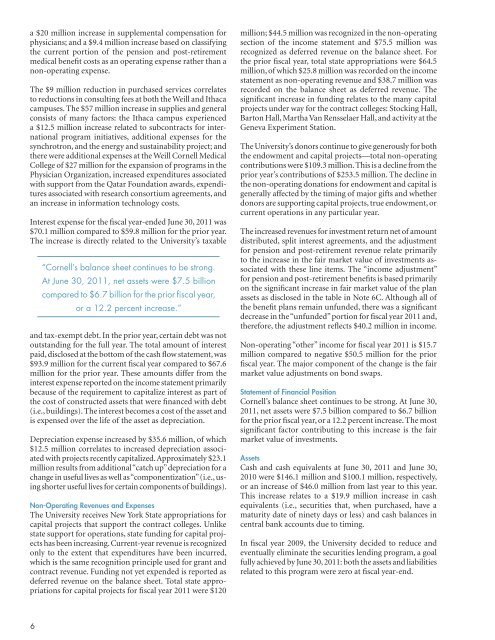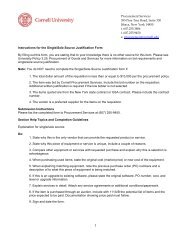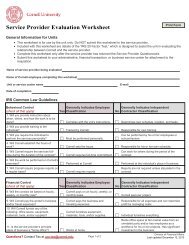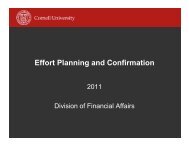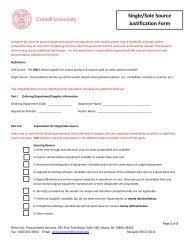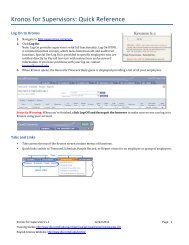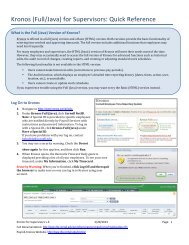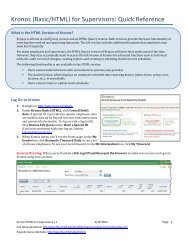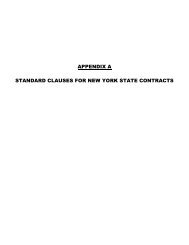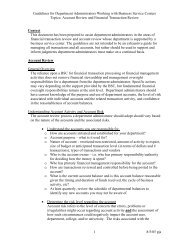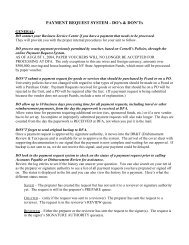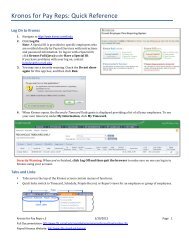Annual Report - DFA Home - Cornell University
Annual Report - DFA Home - Cornell University
Annual Report - DFA Home - Cornell University
Create successful ePaper yourself
Turn your PDF publications into a flip-book with our unique Google optimized e-Paper software.
a $20 million increase in supplemental compensation for<br />
physicians; and a $9.4 million increase based on classifying<br />
the current portion of the pension and post-retirement<br />
medical benefit costs as an operating expense rather than a<br />
non-operating expense.<br />
The $9 million reduction in purchased services correlates<br />
to reductions in consulting fees at both the Weill and Ithaca<br />
campuses. The $57 million increase in supplies and general<br />
consists of many factors: the Ithaca campus experienced<br />
a $12.5 million increase related to subcontracts for international<br />
program initiatives, additional expenses for the<br />
synchrotron, and the energy and sustainability project; and<br />
there were additional expenses at the Weill <strong>Cornell</strong> Medical<br />
College of $27 million for the expansion of programs in the<br />
Physician Organization, increased expenditures associated<br />
with support from the Qatar Foundation awards, expenditures<br />
associated with research consortium agreements, and<br />
an increase in information technology costs.<br />
Interest expense for the fiscal year-ended June 30, 2011 was<br />
$70.1 million compared to $59.8 million for the prior year.<br />
The increase is directly related to the <strong>University</strong>’s taxable<br />
“<strong>Cornell</strong>’s balance sheet continues to be strong.<br />
At June 30, 2011, net assets were $7.5 billion<br />
compared to $6.7 billion for the prior fiscal year,<br />
or a 12.2 percent increase.”<br />
and tax-exempt debt. In the prior year, certain debt was not<br />
outstanding for the full year. The total amount of interest<br />
paid, disclosed at the bottom of the cash flow statement, was<br />
$93.9 million for the current fiscal year compared to $67.6<br />
million for the prior year. These amounts differ from the<br />
interest expense reported on the income statement primarily<br />
because of the requirement to capitalize interest as part of<br />
the cost of constructed assets that were financed with debt<br />
(i.e., buildings). The interest becomes a cost of the asset and<br />
is expensed over the life of the asset as depreciation.<br />
Depreciation expense increased by $35.6 million, of which<br />
$12.5 million correlates to increased depreciation associated<br />
with projects recently capitalized. Approximately $23.1<br />
million results from additional “catch up” depreciation for a<br />
change in useful lives as well as “componentization” (i.e., using<br />
shorter useful lives for certain components of buildings).<br />
Non-Operating Revenues and Expenses<br />
The <strong>University</strong> receives New York State appropriations for<br />
capital projects that support the contract colleges. Unlike<br />
state support for operations, state funding for capital projects<br />
has been increasing. Current-year revenue is recognized<br />
only to the extent that expenditures have been incurred,<br />
which is the same recognition principle used for grant and<br />
contract revenue. Funding not yet expended is reported as<br />
deferred revenue on the balance sheet. Total state appropriations<br />
for capital projects for fiscal year 2011 were $120<br />
million; $44.5 million was recognized in the non-operating<br />
section of the income statement and $75.5 million was<br />
recognized as deferred revenue on the balance sheet. For<br />
the prior fiscal year, total state appropriations were $64.5<br />
million, of which $25.8 million was recorded on the income<br />
statement as non-operating revenue and $38.7 million was<br />
recorded on the balance sheet as deferred revenue. The<br />
significant increase in funding relates to the many capital<br />
projects under way for the contract colleges: Stocking Hall,<br />
Barton Hall, Martha Van Rensselaer Hall, and activity at the<br />
Geneva Experiment Station.<br />
The <strong>University</strong>’s donors continue to give generously for both<br />
the endowment and capital projects—total non-operating<br />
contributions were $109.3 million. This is a decline from the<br />
prior year’s contributions of $253.5 million. The decline in<br />
the non-operating donations for endowment and capital is<br />
generally affected by the timing of major gifts and whether<br />
donors are supporting capital projects, true endowment, or<br />
current operations in any particular year.<br />
The increased revenues for investment return net of amount<br />
distributed, split interest agreements, and the adjustment<br />
for pension and post-retirement revenue relate primarily<br />
to the increase in the fair market value of investments associated<br />
with these line items. The “income adjustment”<br />
for pension and post-retirement benefits is based primarily<br />
on the significant increase in fair market value of the plan<br />
assets as disclosed in the table in Note 6C. Although all of<br />
the benefit plans remain unfunded, there was a significant<br />
decrease in the “unfunded” portion for fiscal year 2011 and,<br />
therefore, the adjustment reflects $40.2 million in income.<br />
Non-operating “other” income for fiscal year 2011 is $15.7<br />
million compared to negative $50.5 million for the prior<br />
fiscal year. The major component of the change is the fair<br />
market value adjustments on bond swaps.<br />
Statement of Financial Position<br />
<strong>Cornell</strong>’s balance sheet continues to be strong. At June 30,<br />
2011, net assets were $7.5 billion compared to $6.7 billion<br />
for the prior fiscal year, or a 12.2 percent increase. The most<br />
significant factor contributing to this increase is the fair<br />
market value of investments.<br />
Assets<br />
Cash and cash equivalents at June 30, 2011 and June 30,<br />
2010 were $146.1 million and $100.1 million, respectively,<br />
or an increase of $46.0 million from last year to this year.<br />
This increase relates to a $19.9 million increase in cash<br />
equivalents (i.e., securities that, when purchased, have a<br />
maturity date of ninety days or less) and cash balances in<br />
central bank accounts due to timing.<br />
In fiscal year 2009, the <strong>University</strong> decided to reduce and<br />
eventually eliminate the securities lending program, a goal<br />
fully achieved by June 30, 2011: both the assets and liabilities<br />
related to this program were zero at fiscal year-end.<br />
6


